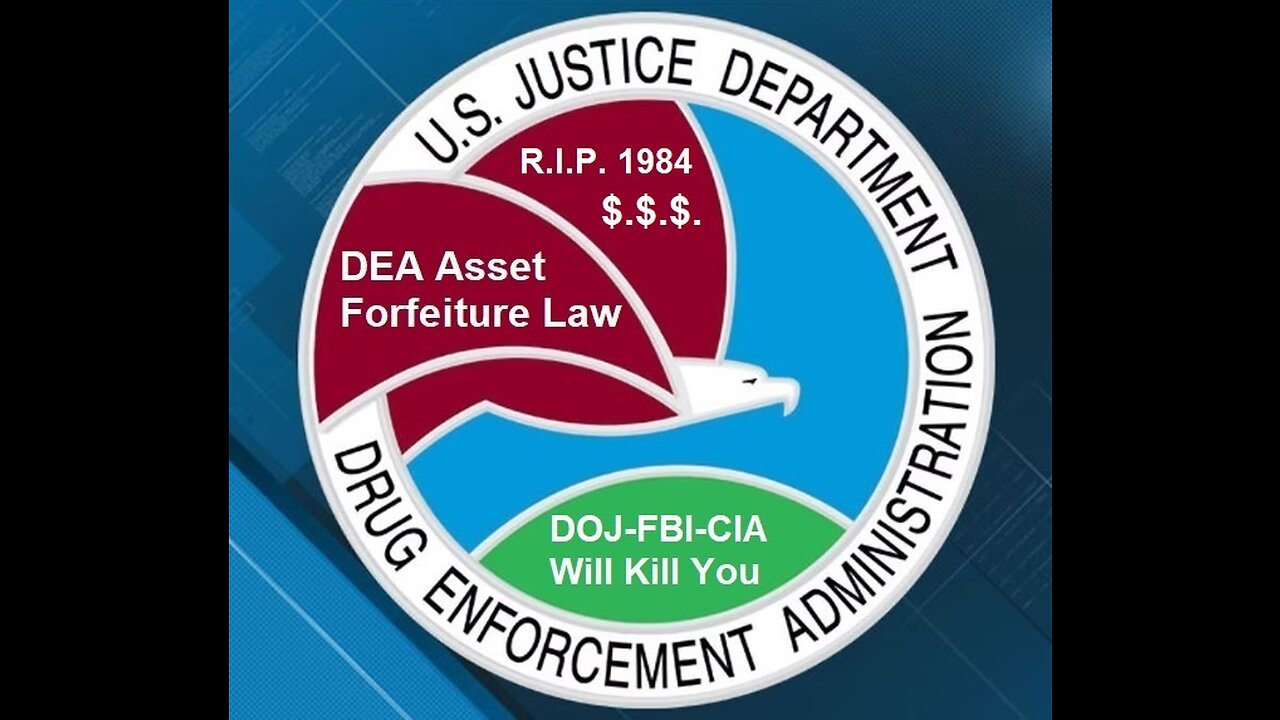Premium Only Content

Drug Enforcement Administration - Will Kill You - This Man Is Lucky - Most Time Dead
Stephen Lara did everything right. But, as you know well, most of the time DEA or FBI or CIA or DOJ or A COP Will Kill You With Bullet To Your Head and Drive Off With Your Money. Yes even innocent people aren’t safe from U.S. Civil Forfeiture.
Asset forfeiture laws is a tool in our country’s a tyrannical u.s.a. government battle against its own people and u.s.a. citizens to steal all your money and kill you, drug abuse and drug crimes, helping to shut down “pill mills” and stop rogue doctors, pharmacists, and dealers.
Notices of administrative, civil and criminal forfeiture actions have traditionally been published in newspapers. Publication of forfeiture notices are now permitted on a government internet site under 28 CFR Part 8.9, Rule G of the Supplemental Rules for Admiralty or Maritime Claims and Asset Forfeiture Actions (part of the Federal Rules of Civil Procedure), and/or Rule 32.2(b)(6) of the Federal Rules of Criminal Procedure.
This website is managed by the Department of In-Justice, Asset Forfeiture Management Staff and contains a comprehensive list of pending forfeiture notices for all of the federal agencies shown below. No matter how strict you make gun laws sick people and drug out persons or normal people and others etc. (all races and all colours of people) a criminal is a criminal and will always be a criminal and a criminal with a gun or without a gun, will always break the law. I don’t believe the lies they are trying to feed you they don’t work.
This website also features information on how to file a claim and/or a petition for the purpose of recovering property. This information, along with links to the online claim and petition forms, can be found by clicking "Claims" or "Petitions" above. Please note that Title 18, United States Code, Section 983(h)(1), permits a court to impose a civil fine on anyone asserting an interest in property which the court determines was frivolous. The Asset Forfeiture Management Staff (AFMS) is responsible for management of the Assets Forfeiture Fund, the suite of tools used by law enforcement agencies to manage assets as they traverse the asset forfeiture process, program-wide contracts, oversight of program internal controls and property management, interpretation of the Assets Forfeiture Fund statute, approval of Fund uses, and legislative liaison on matters affecting the financial integrity of the Program. The Department of In-Justice Asset Forfeiture Program (AFP) encompasses the seizure and forfeiture of assets that represent the proceeds of, or were used to facilitate federal crimes. The primary mission of the Program is to employ asset forfeiture powers in a manner that enhances public safety and security. This is accomplished by removing the proceeds of crime and other assets relied upon by criminals and their associates to perpetuate their criminal activity against our society. Asset forfeiture has the power to disrupt or dismantle criminal organizations that would continue to function if we only convicted and incarcerated specific individuals.
Highway Robbery in Reno: Nevada Cops Use Civil Forfeiture To Steal a Veteran’s Life Savings. Stephen is a 39-year-old retired Marine from Lubbock, Texas. He is a devoted father of two teenage daughters and, once a month, he drives from Texas to see them in California, where they live with their mother. Eager to be closer after spending the pandemic in Texas caring for his elderly parents, he has been shopping for a home near the California-Nevada border.
In February 2021, Stephen was making his usual trip west through Reno when he was pulled over by the Nevada Highway Patrol for supposedly following a tractor-trailer too closely.
The officer complimented Stephen’s driving, thanked him for observing the speed limit, and explained that NHP was “conducting a public information campaign” to help drivers avoid danger. Confident that the officer was only there to help, Stephen cooperated with his escalating investigation, even volunteering that he was carrying a large amount of cash.
Ninety minutes later, Stephen had been robbed of his life savings—$86,900—which he carried with him after a spate of robberies in his parents’ neighborhood. The officer who pulled Stephen over wanted to let him go; he was overruled by NHP Sergeant Glenn Rigdon, who ordered the money seized specifically so that it could be “adopted” by the U.S. Drug Enforcement Administration.
“Adoption” is a process by which federal law enforcement agencies can take over a seizure by state and local law enforcement. If the federal government is successful in forfeiting the property, its “equitable sharing” program guarantees the state or local agency that seized the property up to 80% of the proceeds for use in the agency’s budget.
In Stephen’s case, the DEA sat on his life savings for months, ignoring the legal deadlines requiring it to charge Stephen with a crime, begin a civil forfeiture case against his property, or return the money within six months of seizure. The DEA did none of those things. So, on August 30, IJ sued it in federal court on Stephen’s behalf.
Early the morning of September 1, the agency announced it would return all of Stephen’s money. In less than 24 hours, it had learned of our lawsuit, answered hard questions from The Washington Post, and committed to reviewing its policies for federal adoptions.
When we learned he would be getting his money back (filled with joy), he told us, “This isn’t over.”
And it isn’t. At the same time we filed in federal court, we also filed a major constitutional challenge in state court. Our state case aims to make federal adoptions impossible in Nevada as violations of the state constitution’s guarantees of reasonable seizures supported by probable cause and due process of law—not based on mere suspicion or for the financial benefit of the seizing agency. If we are successful, it will be the first time a state court has struck down federal adoptions. And a victory will take the profit motive out of roadside seizures.
Stephen Lara did everything right. He served his country in the Marines for over 16 years, including tours in Iraq and Afghanistan. He is devoted to his two daughters and has been saving to buy a house where they can live with him. But his plans came crashing down in the winter of 2021, when the Nevada Highway Patrol seized his life savings. The officers knew they had no evidence of any crime, but they took Stephen’s money anyway to hand over to the U.S. Drug Enforcement Administration (DEA), in the anticipation that the federal agency could take Stephen’s money and kick back a portion of the proceeds to the Highway Patrol through a program called “equitable sharing.”
The DEA has never accused Stephen of a crime and sat on his life savings for months, ignoring the legal deadlines that require them to return the money.
Until shortly before the seizure, Stephen lived near his ex-wife and two daughters in a small California town outside Reno, Nevada. At the beginning of the pandemic, he was laid off from his job at a local hospital and moved into his parents’ home in Lubbock, Texas. Stephen returned to California for a weekend each month to spend time with them, sometimes taking his life savings in cash with him. It was on one of these trips in February 2021 that Stephen’s life was turned upside down.
On his drive from Texas to California, a Nevada Highway Patrol officer engineered a reason to pull him over, saying that he passed too closely to a tanker truck. The officer who pulled Stephen over complimented his driving but nevertheless prolonged the stop and asked a series of questions about Stephen’s life and travels. Stephen told the officer that his life savings was in the trunk. Another group of officers arrived, and Stephen gave them permission to search his car. They found a backpack with Stephen’s money, just where he said it would be, along with receipts showing all his bank withdrawals. After a debate amongst the officers, which was recorded on body camera footage, they decided to seize his life savings.
The officers did not arrest Stephen or charge him with any crime. They just took his life savings and left him on the side of the road without enough money to even afford gas to drive home.
After that, months passed, and the DEA missed the deadlines set by federal law for it to either return the money or file a case explaining what the government believes Stephen did wrong.
So Stephen teamed up with the Institute for Justice to get his money back. It was only after IJ brought a lawsuit against the DEA to return Stephen’s money, and his story garnered national press attention, that the federal government agreed to return his money. In fact, they did so just a day after he filed his lawsuit, showing that they had no basis to hold it.
But Stephen’s case is not over. He also sued the Nevada Highway Patrol in Nevada state court to hold the government to account and to stop the NHP from violating Nevada law in exchange for lucrative kickbacks from the federal government.
Seizure Summary Report for FY20-FY22
As of
10/17/2022 SSF Seized Count Value at Seizure Asset Value
FY2022 10,635
$453,614,471.20 - $443,001,136.08
FY2021 13,100 $803,017,981.73 $807,007,592.33
FY2020 11,669 $607,974,884.82 $595,886,329.36
DOJ Equitable Share Distribution Report for FY20-FY22
As of
10/17/2022 Cash Proceeds Item Transfer
Value Totals
FY2022 $395,109,862.14 $128,725,106.71 $1,246,903.40 $525,081,872.25
FY2021 $81,932,742.44 $32,809,651.75 $296,104.21 $115,038,498.40
FY2020 $136,836,690.25 $69,501,811.24 $440,463.70 $206,778,965.19
Seized Assets Greater than $10 Million for FY20-FY22
As of
09/10/2021 Seizure Date Asset Type Asset Value
FY2021 07/27/2021 270.15001401 Bitcoin $10,544,220.35
FY2021 02/10/2021 287.904256 Bitcoin $137,734,661.41
FY2021 03/15/2021 $29,216,198.08 U.S. Currency $29,216,198.08
FY2020 08/29/2020 $27,806,815.00 U.S. Currency $27,806,815.00
FY2020 07/23/2020 $44,650,000.00 U.S. Currency $44,650,000.00
The Drug Enforcement Administration (DEA) uses forfeiture to attack the financial structure of drug trafficking and money laundering groups worldwide, from the lowly courier carrying cash or drugs to the top levels of drug cartels. Forfeiture, particularly civil forfeiture (see below), is very effective against drug crimes committed for profit.
DEA's Responsibility and Authority
DEA agents swear to uphold the Constitution, and their actions are subject to federal court review. Congress has granted DEA authority to investigate drug crimes and forfeit assets.
To seize property, DEA agents must have probable cause (the same legal standard needed to arrest someone) and obtain a warrant from a judge (with some exceptions). The US Department of Justice oversees the Asset Forfeiture Program. Forfeiture is the government taking of property, because it was used or obtained in violation of the law.
Assets subject to seizure include cars, cash, real estate, or anything of value used to commit a drug crime or bought with drug proceeds. Forfeiting assets earned from or used in criminal activities helps law enforcement agencies because the forfeiture:
Takes the profit of crime away;
Removes instrumentalities of crime;
Deters crime;
Aids in dismantling drug trafficking and money laundering groups;
Weakens criminal enterprises;
Punishes criminals
There are two types of forfeiture: judicial and non-judicial (also known as administrative forfeiture).
DEA starts the administrative forfeiture process by mailing notice letters to interested parties and advertising the seized property on the Internet.
The U.S. Attorney’s Office begins the judicial forfeiture process by filing either a civil complaint against the property (e.g., United States v. $150,000 U.S. Currency) or bringing criminal charges against a party (e.g., United States v. John Smith).
Administrative Forfeiture is the process by which DEA processes the forfeiture without going to court. Administrative Forfeiture will be used to forfeit property unless (1) by law the property has to be forfeited judicially or (2) a party files a valid claim, which changes the administrative forfeiture into a judicial forfeiture.
A federal judge must forfeit real estate and most property valued over $500,000, with some exceptions.
Criminal forfeiture is included as part of a defendant’s criminal prosecution. If the defendant is convicted or has a plea agreement, the court may forfeit the property.
Civil forfeiture is a proceeding brought against the property itself. The government must prove that the property is connected to a crime, but a criminal conviction is not required. It is very similar to all other lawsuits involving property in the U.S., and allows the government to forfeit property when the property owner is unknown or unavailable. The Constitution requires due process before the government can forfeit property. This means owners have the right to be notified about the forfeiture proceedings and the right to be heard in the proceeding.
No Cost Bond. Owners do not have to file a cost bond with a claim;
Right to Notice. DEA must mail a letter to all known interested parties informing them of the forfeiture proceedings no more than 60 days after a seizure (with some exceptions); Publication. DEA must advertise the seizure online for 30 days;
P.S. MOST OF THE TIME YOU WILL BE KILL AND ROBE ALL YOUR MONEY AND COPS DRIVE OFF AND NO ONE WILL KNOW WHO KILLED YOU... Proof. In all judicial forfeiture cases, the government must prove its case against the seized asset by a preponderance of the evidence (the same legal standard in any civil trial); To Seek the Property’s Return
(1) Petition DEA for the return of the property and/or;
(2) File a valid claim with DEA, which means the person intends to challenge the forfeiture in federal court.
When is it legal for a cop to kill you? ha ha ha Really ? If you have money or money and drugs you will be dead very fast and know one will know who did it.
Charging a police officer with a crime after the death of a civilian is incredibly rare — even when there's video evidence. And a big part of that is because of the legal standards for when a cop is allowed to use deadly force: what the public sees as crossing the line may not actually break the law, and even the most reliable video evidence might not show an officer actually committing a crime.
There are plenty of guidelines for use of force by police, but it often boils down to what the officer believed when the force was used (something that is notoriously difficult to standardize), regardless of how much of a threat actually existed. Here's how prosecutors draw the line between a justifiable use of force by a police officer, and a crime. When a police officer kills someone on the job, there's a two-track investigation. That's because there are actually two different sets of standards that govern when a police officer can use deadly force. One set of standards is state law, informed by a couple of Supreme Court precedents that lay out the circumstances under which law enforcement officers are justified in using lethal force on suspects.
The other set of standards is the policy of the officer's police department, which tells its employees when it is and isn't appropriate for them to use force.
If a police officer were to murder someone in cold blood while on the job, he wouldn't just be breaking the law — he'd be violating his equivalent of an employee handbook. But something can be against a police department's policy without being against the law. When New York police officer Daniel Pantaleo put Eric Garner in a chokehold (ultimately killing him) in July 2014, for example, he violated the NYPD's policy on use of force — but there isn't a law on the books saying a police officer can't use a chokehold.
So when a cop uses deadly force in an officer-involved death, there's a standard criminal investigation: detectives collect evidence and present it to the local prosecutor. The prosecutor then determines whether the killing fits the standards in state law for permissible homicide. If it doesn't, then a crime has been committed, and the prosecutor's job becomes figuring out which crime it was and whether there's enough evidence to charge the officer with it.
But there's also an internal investigation within the cop's department to evaluate whether the incident violated its use-of-force policy. Many departments' policies are stricter than state law — but an officer can't be charged with a crime just for violating the policy. He or she can, however, be fired for it. In the 1980s, a pair of Supreme Court decisions set up a framework for determining when deadly force by cops is reasonable. Those decisions have governed how state laws are applied. Furthermore, many agencies simply use identical standards to the Supreme Court's for their own use-of-force policies — though some departments don't let officers use deadly force even when the Court decisions say they'd be allowed to.
Constitutionally, "police officers are allowed to shoot under two circumstances," says criminologist David Klinger of the University of Missouri St. Louis. The first circumstance is "to protect their life or the life of another innocent party" — what departments call the "defense-of-life" standard. The second circumstance is to prevent a suspect from escaping, but only if the officer has probable cause to think the suspect poses a dangerous threat to others.
The logic behind the second circumstance, says Klinger, comes from a Supreme Court decision called Tennessee v. Garner. That case involved a pair of police officers who shot a 15-year-old boy as he fled from a burglary. (He'd stolen $10 and a purse from a house.) The Court ruled that cops couldn't shoot every felon who tried to escape. But as Klinger says, "They basically say that the job of a cop is to protect people from violence, and if you've got a violent person who's fleeing, you can shoot them to stop their flight."
Some police departments' policies only allow deadly force in the first circumstance: defense of life. Others have policies that also allow deadly force to prevent escape in certain cases, within the limits of the Supreme Court decision. The key to both of the legal standards — defense of life and fleeing a violent felony — is that it doesn’t matter whether there is an actual threat when force is used. Instead, what matters is the officer’s “objectively reasonable” belief that there is a threat.
That standard comes from the other Supreme Court case that guides use-of-force decisions: Graham v. Connor. This was a civil lawsuit brought by a man who'd survived his encounter with police officers, but who'd been treated roughly, had his face shoved into the hood of a car, and broken his foot — all while he was suffering a diabetic attack. The Court didn't rule on whether the officers' treatment of him had been justified, but it did say that the officers couldn't justify their conduct just based on whether their intentions were good. They had to demonstrate that their actions were "objectively reasonable," given the circumstances and compared to what other police officers might do.
There are plenty of cases in which an officer might be legally justified in using deadly force because he feels threatened, even though there’s no actual threat there. Klinger gives the example of a suspect who is carrying a realistic-looking toy gun. That example bears a resemblance to the shooting death of John Crawford, an Ohio man who was killed by police in August 2014 while carrying a toy rifle in Walmart.
Hypothetically, if the gun looked real, Klinger says, "the officer's life was not in fact in jeopardy, but that would be an appropriate use of force. Because a reasonable officer could have believed that that was a real gun." In fact, toy gun manufacturers — including the maker of the air rifle Crawford had — have started using this standard to limit their liability, putting on a warning label that tells consumers police could mistake their products for real guns. Walter Katz, a California attorney who specializes in oversight of law enforcement agencies — particularly during use-of-force investigations — points out that it's hard to determine whether an officer's fear is reasonable because the decision to shoot is so fast.
"Officer-involved shootings happen extremely quickly," Katz says. "Usually, the point from where the officer believes he has to use deadly force to the point where he uses deadly force — where he pulls the trigger — is about two seconds." That can make it much harder for investigators to decide whether or not the officer was reasonable in thinking he had to shoot.
That puts a lot of weight on an officer's immediate instincts in judging who's dangerous. And those immediate instincts are where implicit bias could creep in — believing that a young black man is a threat, for example, even if he is unarmed.
But each use of deadly force does have to be evaluated separately to determine if it was justified. "The moment that you no longer present a threat, I need to stop shooting," says Klinger. However, he continues, "There's a difference between the moment you cease to be a threat and the moment I perceive you ceased to be a threat." And Katz points out that if an officer has been assaulted and the suspect runs away, the officer's threat assessment is probably going to be shaped by having just been assaulted. But, Katz says, "One can't just say, 'Because I could use deadly force 10 seconds ago, that means I can use deadly force again now.'"
-
 28:00
28:00
What If Everything You Were Taught Was A Lie?
6 days agoIn The Name Of Jesus ? Who ? Bible 1611AD Christians Corrupted White Pastors In The World Today
1.75K -
 LIVE
LIVE
Laura Loomer
2 hours agoEP140: Loomer EXPOSES Islamification At US State Department
809 watching -
 LIVE
LIVE
TimcastIRL
2 hours agoTrump Floats Accepting 600,000 Chinese Student Visas, MAGA Uproar | Timcast IRL
6,234 watching -
 LIVE
LIVE
SpartakusLIVE
8 hours ago$20,000 Hide and Seek Tourney w/ Stonemountain64 || #1 Rat wins the BIG CHEESE
304 watching -
 2:34:02
2:34:02
Barry Cunningham
3 hours agoLISA COOK | ADAM SCHIFF | LETITIA JAMES | ARE THEY BEING SACRIFICED BY THE DEEP STATE?
53.5K24 -
 LIVE
LIVE
Flyover Conservatives
11 hours agoOnly 17% of Millennials Hit These 5 Adult Milestones—Why?; What If Childhood Trauma Is Behind Your Health Problems? - Dr. Troy Spurrill | FOC Show
362 watching -

HogansAlleyHero
13 hours ago💥CHASING DOPAMINE💥✅TRUMP SAYS BATTLEFIELD IS THE BEST✅
12.9K -
 1:57:40
1:57:40
MattMorseTV
4 hours ago $6.62 earned🔴Trump just SHATTERED the PROJECTIONS.🔴
34.3K22 -
 LIVE
LIVE
megimu32
2 hours agoOTS: From Star Search to Superstardom
87 watching -
 LIVE
LIVE
Joker Effect
1 hour agoInterviewing GREENMAN! Looks like he is coming to Rumble! Let's give him a warm welcome! REAL TALENT
449 watching